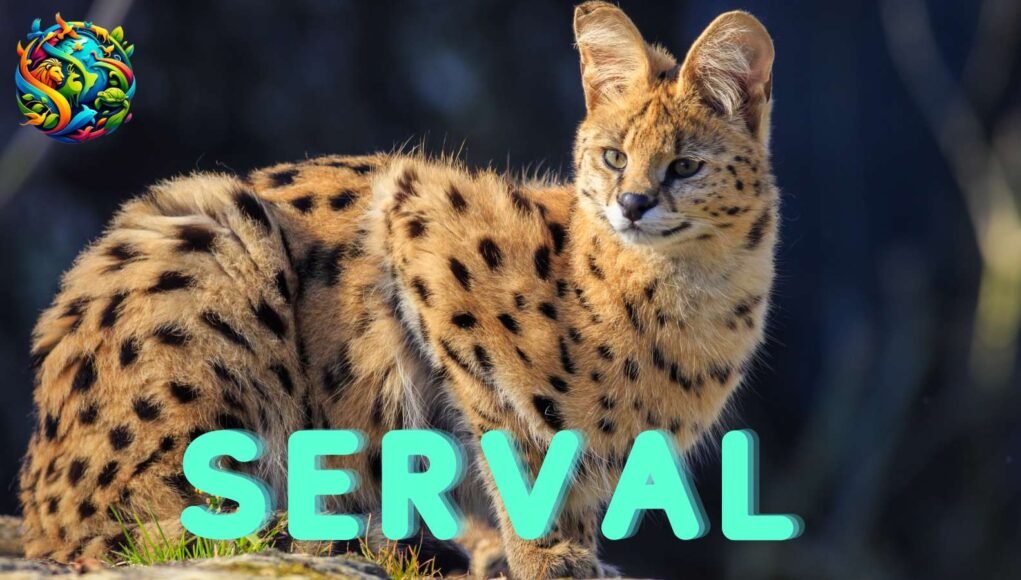Introduction
The serval (Leptailurus serval) is a slender, long-legged wild cat native to Africa. Known for its striking golden coat adorned with black spots and stripes, it is an agile hunter and a master of stealth. Unlike its larger relatives, such as lions and leopards, it is a medium-sized feline with unique adaptations that make it one of the most efficient predators of its size.
This elusive creature thrives in the savannas and wetlands of Africa, where it plays a crucial role in maintaining ecological balance by controlling rodent populations. Despite its wild nature, it has also gained attention in the exotic pet trade, raising ethical and conservation concerns. In this article, we will explore the it’s habitat, behavior, diet, and the threats it faces in the wild.
Amazing Facts About the Serval
- Leaping Mastery – It can leap up to 10 feet (3 meters) in the air to catch birds in flight.
- Largest Ears Among Wild Cats – Their disproportionately large ears give them an exceptional sense of hearing, helping them detect prey moving underground.
- High Success Rate in Hunting – Unlike most wild cats, which succeed in hunting around 20% of the time, these boast an astonishing 50% success rate.
- Unique Purring and Chirping Sounds – While it can purr like domestic cats, they also produce a variety of vocalizations, including chirps and growls.
- Specialized Paws – Their long legs and specialized toes allow them to navigate swampy areas effortlessly.
- Longevity – In the wild, these can live up to 10 years, while in captivity, they may live up to 20 years.
Habitat and Geographic Range
Servals are predominantly found in sub-Saharan Africa, inhabiting areas with tall grasses and abundant water sources. They prefer:
- Wetlands and Swamps – These environments provide an ample supply of rodents, birds, and amphibians.
- Savannas and Grasslands – The tall grasses offer excellent cover for stalking prey.
- Woodlands and Forest Edges – Though less common, some of these are found in denser vegetative areas.
Unlike larger felines, they avoid dense forests and arid deserts, as these environments do not support their primary food sources.
Diet and Hunting Techniques
These are carnivorous and primarily feed on small mammals, but they are opportunistic hunters with a varied diet.
Primary Prey
- Rodents – Make up about 80% of their diet.
- Birds – Often snatched mid-air due to their incredible jumping ability.
- Amphibians and Reptiles – Common in wetland habitats.
- Insects and Fish – Consumed occasionally when other food sources are scarce.
Hunting Strategy
They rely on their acute sense of hearing to detect prey moving underground. They employ a ‘stalk and pounce’ technique, using their long legs to spring into action. Their ability to leap great distances helps them catch birds and even fish in shallow waters.
Behavior and Social Structure
Unlike lions, these are solitary creatures, coming together only for mating. They establish territories using scent marking and vocalizations.
- Activity – Mostly nocturnal but sometimes active during dawn and dusk.
- Territory Size – Males control larger territories, often overlapping with several females.
- Communication – Uses vocalizations, urine spraying, and claw marks to signal other servals.
Reproduction and Lifespan
- Mating Season – Varies by region but occurs year-round.
- Gestation Period – Around 74 days.
- Litter Size – Usually 2-3 kittens, born blind and dependent on their mother.
- Maternal Care – Mothers provide food and protection until kittens become independent at 6-8 months.
Predators and Threats
While these are skilled hunters, they face threats from both natural predators and human activities.
Natural Predators
- Leopards – Their primary natural predator.
- Hyenas and Wild Dogs – Occasionally prey on these.
- Large Birds of Prey – Can target young these.
Human-Induced Threats
- Habitat Destruction – Expansion of agriculture reduces their hunting grounds.
- Illegal Wildlife Trade – Demand for exotic pets and fur threatens populations.
- Conflict with Farmers – Perceived as a threat to livestock, though they primarily hunt rodents.
Conservation Status and Efforts
These are classified as Least Concern by the IUCN, but some populations are declining due to habitat loss and poaching. Conservation efforts include:
- Protected Reserves – Many African national parks serve as safe havens.
- Anti-Poaching Laws – Enforced in several countries to curb illegal hunting.
- Education Programs – Raising awareness about the importance of servals in ecosystems.
Servals in Captivity and Popular Culture
Due to their exotic appearance, servals are sometimes kept as pets, but they require specialized care and large enclosures. They have also been featured in wildlife documentaries and educational programs that showcase their remarkable agility and hunting skills.
Movies and Documentaries Featuring Servals:
- Big Cat Diary (BBC) – Features footage of servals in their natural habitat.
- The Lion Guard (Disney) – Animated servals appear as supporting characters.
- Planet Earth II (BBC) – Highlights servals’ hunting techniques.
Pronunciation of ‘Serval’ in Different Languages
- English: /ˈsɜːrvəl/
- French: /sɛʁ.val/
- Spanish: /sɛrˈval/
- German: /ˈzɛr.val/
- Mandarin Chinese: 薮猫 (Sǒu māo)
- Japanese: サーバルキャット (Sābaru kyatto)
- Russian: Сервал (Serval)
FAQs About Servals
Q: Are servals dangerous to humans?
A: While servals are wild animals and should not be handled by untrained individuals, they are generally not aggressive toward humans.
Q: Can servals be domesticated?
A: No, servals are wild cats and require specialized care. However, hybrids like the Savannah cat (a serval-domestic cat mix) exist.
Q: What is the main role of servals in the ecosystem?
A: They control rodent populations, preventing crop damage and disease spread.
The serval, with its incredible agility, keen senses, and striking beauty, remains one of Africa’s most captivating predators. As conservation efforts continue, understanding and protecting these elegant wild cats will ensure their place in the natural world for generations to come.




